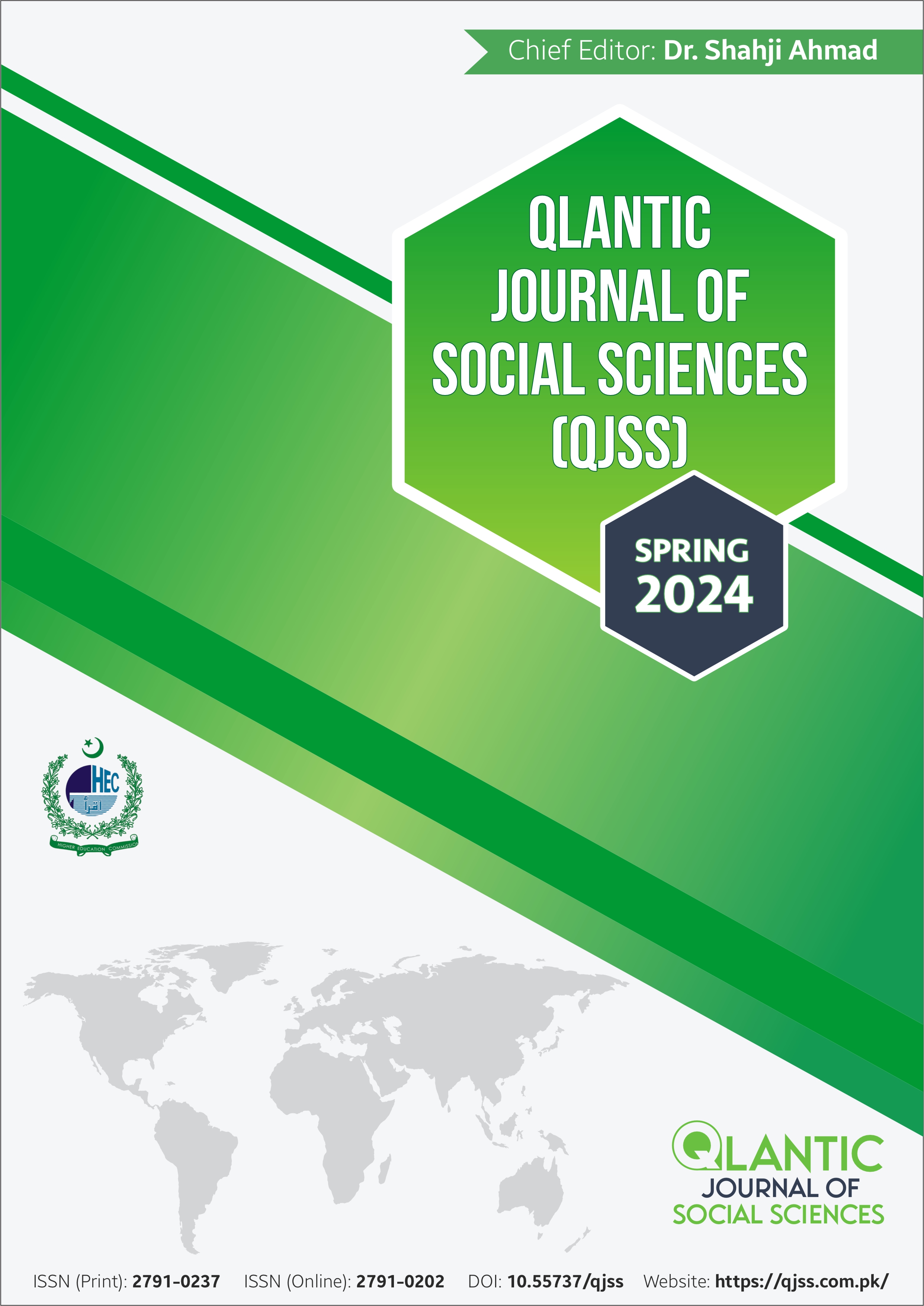Exploring Teachers’ Perception and Practices About the Provision of Social-Emotional Learning at Primary Grades in Karachi, Pakistan
DOI:
https://doi.org/10.55737/qjss.813513390Keywords:
Social Emotional Learning, Students’ Engagement, Relationship Management, Emotion Regulation, Academic AchievementAbstract
The current study aimed to explore how teachers perceive the term Social Emotional Learning (SEL) in primary grades. This research also explored the practices of provision of SEL at schools from the lens of school heads and teachers. The research design adopted for the study was qualitative, and a purposive sampling technique was used to identify two school systems where SEL is taught formally as a subject in Karachi, Pakistan. To collect the perceptions, practices, and experiences of SEL teaching, semi-structured in-depth interviews were conducted with the teachers and school heads from these schools. Tools used for the semi-structured in-depth interviews were reviewed by the schools’ educational psychologists. The findings indicate that teachers considered SEL as the driving force to ensure academic improvement and behavior management. SEL is also found to improve the physical and mental well-being of the students. The practices adopted by the school for the provision of SEL include innovative teaching methodologies, curriculum designing and monitoring, professional development, assessment, parental involvement, and integration of SEL with different subjects. Overall, the factors found associated with the SEL in primary grades are embedding SEL in school culture, involvement of all stakeholders, encouraging the school environment, and implanting SEL competencies in the SEL curriculum.
References
Aldrup, K., Carstensen, B., Köller, M. M., & Klusmann, U. (2020). Measuring Teachers’ Social-Emotional Competence: Development and Validation of a Situational Judgment Test. Frontiers in Psychology, 11. https://doi.org/10.3389/fpsyg.2020.00892
Bandura, A. (1977). Self-efficacy: Toward a unifying theory of behavioral change https://doi.org/10.1037/0033-295X.84.2.191. Psychological Review, 84(2), 191-215. https://doi.org/10.1037/0033-295X.84.2.191
Bierman, K. L., & Motamedi, M. (2015). SEL programs for preschool children. In J. A. Durlak. https://psycnet.apa.org/record/2015-24776-009
Brackett, M. A., & Cipriano, C. (2020). Teachers are anxious and overwhelmed. They need SEL now more than ever. EdSurge. https://www.edsurge.com/news/2020-04-07-teachers-are-anxious-and-overwhelmed-they-need-sel-now-more-than-ever
Brackett, M. A., & Katulak, M. A. (2006). The Emotionally Intelligent teacher. Ann Arbor, MI: Quest Education. https://joaomfjorge.wordpress.com/wp-content/uploads/2017/07/caf945679ceb8f6dbab8b1eee4127360e73b.pdf
Brackett, M. A., Elbertson, N. A., & Rivers, S. E. (2015). Applying theory to the development of approaches to SEL. In J. A. Durlak, C. E. Domitrovich, R. P. Weissberg, & T. P. Gullotta (Eds.), Handbook of social and emotional learning: Research and practice (pp. 20–32). The Guilford Press.
Bronfenbrenner, U. (1979). The ecology of human development: Experiments by nature and design. Harvard University Press. https://www.hup.harvard.edu/books/9780674224575
CASEL. (2013). Effective Social and Emotional Learning Programs. 2013 CASEL Guide: Preschool and Elementary School Edition. CASEL. https://go.boarddocs.com/il/rps205/Board.nsf/files/A939WN711ED3/$file/Effective%20Social%20and%20Emotional%20Learning%20Programs.pdf
Cohen, J. (1999). Social and emotional learning past and present: A psychoeducational dialogue. In Cohen, J. (ed.). Educating minds and hearts: Social emotional learning and the passage into adolescence.
Cristóvão, A. M., Candeias, A. A., A. A., & Verdasca, J. (2017). Social and emotional learning and academic achievement in Portuguese schools: A bibliometric study. Frontiers in Psychology, 8, 1913. https://doi.org/10.3389/fpsyg.2017.
Denham, S. A. (2018). Keeping SEL developmental: The importance of a developmental lens for fostering and assessing SEL competencies. Collaborative for Academic, Social, and Emotional Learning. https://casel.org/wp-content/uploads/2020/04/Keeping-SEL
Dusenbury, L., Zadrazil, J. M., & Weissberg, R. (2011). State learning standards to advance social and emotional learning: The state scan of social and emotional learning standards, preschool through high school. Collaborative for Academic, Social,.. https://casel.org/wp-content/uploads/2016/01/state-learning-standards-to-advance-social-and-emotionallearning.pdf
Etikan, I., Musa, S. A., & Alkassim, R. S. (2016). Comparison of Convenience Sampling and Purposive Sampling. American Journal of Theoretical and Applied Statistics, 5(1), 1–4. https://doi.org/10.11648/j.ajtas.20160501.11
Freud, S. (1935). New Introductory Lectures on Psycho-Analysis. Archives of Neurology and Psychiatry, 33(5), 1135. https://doi.org/10.1001/archneurpsyc.1935.02250170221019
Jones, S. M., & Bouffard, S. M. (2012). Social and emotional learning in schools: From programs to strategies. 26(4), 1–33. Social Policy Report, 26(4), 1-33. https://doi.org/10.1002/j.2379-3988.2012.tb00073.x
Karim, S., Saeed, K., Rana, M. H., Mubbashar, M. H., & Jenkins, R. (2004). Pakistan mental health country profile. International Review of Psychiatry, 16(1-2), 83–92. https://doi.org/10.1080/09540260310001635131
Kickbush, I. (2012). Learning for Well-Being: A Policy Priority for Children and Youth in Europe. A Process for Change. Calouste Gulbenkian Foundation. https://www.ilonakickbusch.com/kickbusch-wAssets/docs/PG_Executive-Summary_2012--2-.pdf
Kimberly, A. S.-R. (2017). Social Emotional Learning and Teachers. The Future of Children, 27(1), 137–155. https://doi.org/10.1353/foc.2017.0007
Mahoney, J. L., Weissberg, R. P., & Greenberg, M. T. (2020). Systemic social and emotional learning: Promoting educational Success to all Preschool to high school education. American Psychologist, Advance online publication. https://doi.org/10.1037/amp0000701
Margolius, M., Doyle, L. A., Pufall, J. E., & Hynes, M. (2020). The state of young people during COVID-19: Findings fromnationally representative Survey of high school youth. washington, DC:. America's Promise Alliance. https://files.eric.ed.gov/fulltext/ED606305.pdf
Memon, G. R. (2007). Education in Pakistan: The key Issues, problems and the new challenges. Journal of Management and Social Sciences, 3(1), 47-55. https://ibtjbs.ilmauniversity.edu.pk/journal/jbs/3.1/5.%20Education%20in%20Pakistan-The%20Key%20Issues,%20Problems%20and%20The%20New%20Challenges.pdf
Rashid, T. (2010). Development of social skills among children at elementary level . Bulletin of Education and Research, 3(1), 69–78. http://pu.edu.pk/images/journal/ier/PDF-FILES/5-Social%20Skills%20among%20Children%20at%20Elementary%20Level.pdf
Saeed, M., & Mahmood, K. (2002). Assessing competency of Pakistani primary school teachers in mathematics, science and pedagogy. International Journal of Educational Management, 16(4), 190–195. https://doi.org/10.1108/09513540210432173
Salovey, P., & Mayer, J. D. (1990). Emotional Intelligence. Imagination, Cognition and Personality, 9(3), 185–211. Sagepub. https://doi.org/10.2190/DUGG-P24E-52WK-6CDG
Schonertn- Reichl, K. A., Hanson - Peterson, J. L., & Hymel, S. (2016). SEL and preservice teacher education. In J.A Durlak, C.E. Domitovich, R.P. Weissberg & T.p. Gullotta (Eds), Handbook of Social Emotional Learning. Guilford Press: New York.
Schutz, P. A., & Zembylas, M. (2009). Advances in Teacher Emotion Research. Boston, Springer. https://content.e-bookshelf.de/media/reading/L-6084-ad6585d105.pdf
Shaikh, B., Kahloon, A., Kazmi, M., Khalid, H., Nawaz, K., Khan, N., & Khan, S. (2004). Students, Stress and Coping Strategies: A Case of Pakistani Medical School. Education for Health: Change in Learning & Practice, 17(3), 346–353. https://doi.org/10.1080/13576280400002585
Shonkoff, J. P., & Phillips, D. A. (2000). From neurons to neighborhoods: The science of early childhood development. Washington, D.C.: National Academy Press.
Sylwester, R. (2000). A biological brain in a cultural classroom: Applying biological research to classroom management. Thousand Oaks, CA: Corwin Press, Inc.
Yousoff, R. M., & Khan, F. (2013). Stress and burnout in the higher education sector in Pakistan: Asystematic review of literature. Research Journal of Recent Science, 2(11), 90-98. https://www.isca.me/rjrs/archive/v2/i11/13.ISCA-RJRS-2013-213.php




